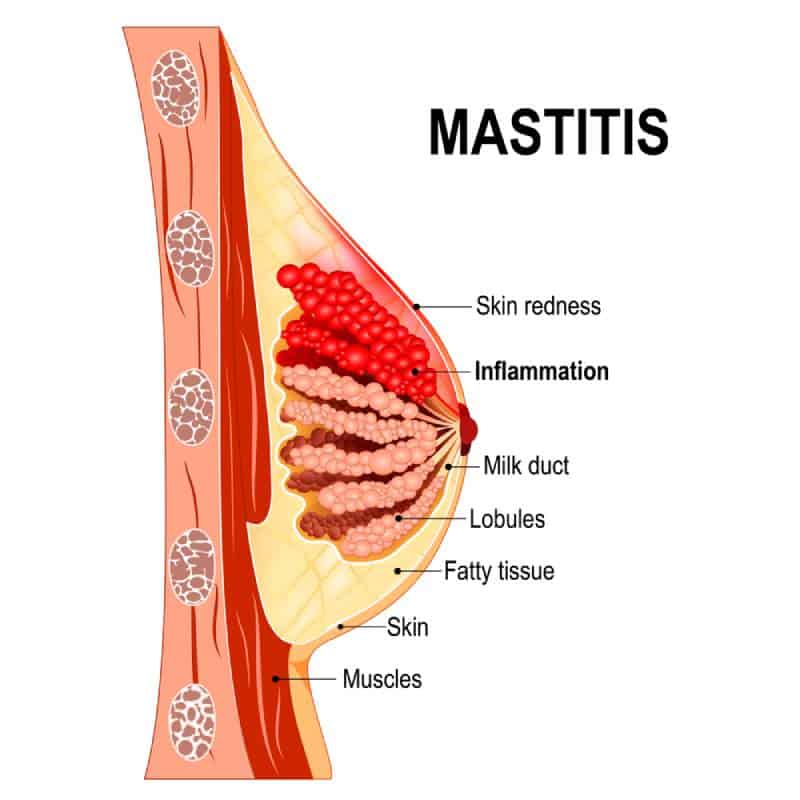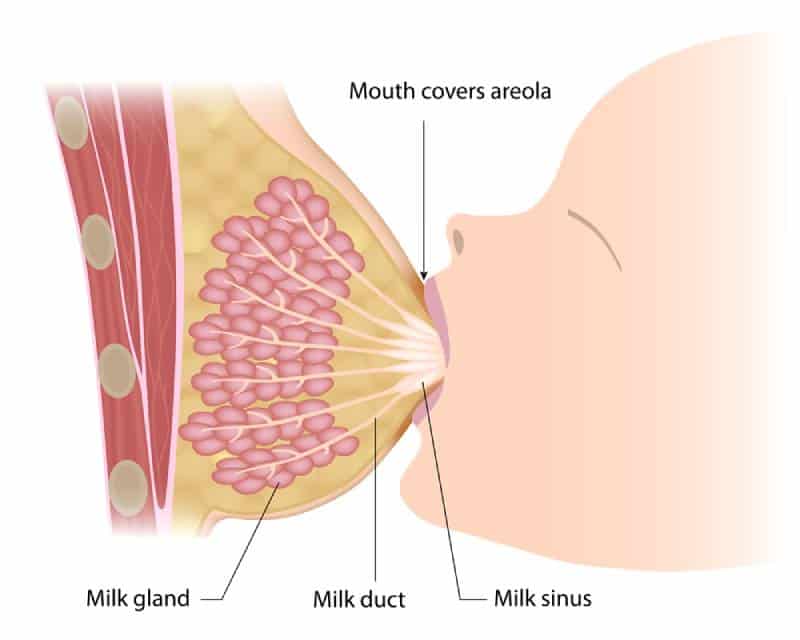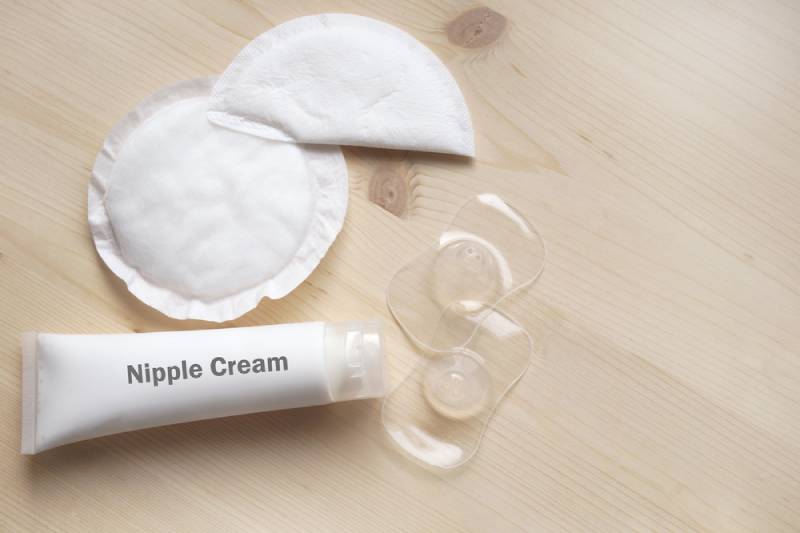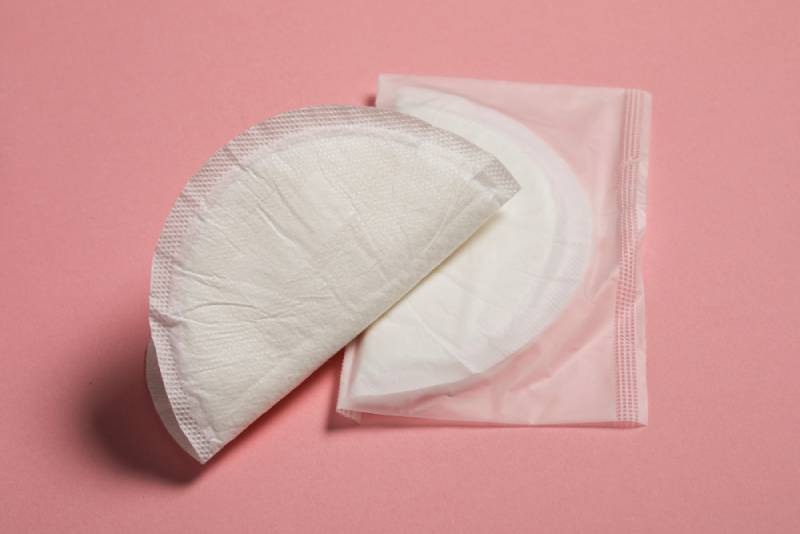Many moms who decide to nurse their newborn soon discover that it’s more difficult than they had expected, and even experience painful breastfeeding.
Painful breastfeeding can be a result of infection and inflammation, so it’s important to identify the cause of the breastfeeding pain to successfully treat it and be able to continue breastfeeding.
If you have decided to breastfeed, you’ve probably done so due to all the amazing benefits that breast milk can bring to your baby.

Unfortunately, many moms stop breastfeeding altogether because the pain is simply unbearable and makes them dread their nursing sessions.
RELATED: 8 Things To Expect When Stopping Breastfeeding Cold Turkey
On the other hand, some breastfeeding pain is normal in the first few days following giving birth to your baby, and moms should be aware of what normal pain feels like so that they know what to expect and when to talk to a doctor or lactation consultant.
In any case, I believe that, under normal circumstances, every mom should be able to enjoy breastfeeding, which is why I’ve prepared useful information on what causes painful breastfeeding and what to do about it, so you can make the best possible decision for your body.
Breastfeeding pain: When is it normal?
When we talk about pain, we talk about a really subjective experience.
You’ve probably heard about something called a “pain threshold” or “pain tolerance,” which refers to the different ways in which we experience pain.
As a result, some women with a lower pain tolerance would find a particular sensation painful, while women with a high pain tolerance would just describe it as discomfort.
This is why many moms have different answers to the question, “Is breastfeeding painful?”
Some talk about breastfeeding as just being uncomfortable from time to time, while others will say it was very painful, causing a lot of new moms to feel confused about what they should expect once they start breastfeeding.
But subjectivity aside, there are ways to make the distinction between painful breastfeeding that is quite normal and isn’t a cause for concern, and pain that has an underlying cause that you should address with your doctor or lactation consultant.

The kind of nipple pain that is completely normal is also called transient soreness, meaning that it usually lasts for a short period of time during the first weeks of breastfeeding.
In fact, as many as 90 percent of moms experience nipple soreness or pain, according to the La Leche League USA.
This means that in the majority of cases, feeling painful nipples when breastfeeding is perfectly normal.
So, when can you expect to feel transient soreness?
Usually right after you start breastfeeding, you might start to experience pain that builds up and reaches its highest level about 3 days after you first started to breastfeed.
Afterward, the level of pain you feel should go down.
Most of the time, you won’t feel any pain within 2 weeks. That being said, there are also other criteria to consider.
For example, your areola and nipple shouldn’t have any cracks or blisters, and there shouldn’t be any bleeding either.

When it comes to feedings, your nipples should look the same prior and post-feeding.
If they look like they have become flat, look pinched, or creased, then it could be a cause for concern.
When your baby latches onto your nipple, it’s perfectly normal to feel some discomfort or even pain (this is where your pain tolerance comes in).
But this type of pain should go away quickly, usually within 30 seconds, and you shouldn’t feel it the whole time you’re nursing.
However, if the pain continues even after you’ve finished your nursing session and you can still feel it when you’re not breastfeeding, then this type of pain doesn’t fall under transient soreness and you should have a chat with your lactation consultant.
Since some women have more sensitive nipples than others, breastfeeding will feel different for every woman.
The key is to really pay attention to your body and listen to the signals it gives you!
When should you talk to a professional?
One of the first signs that the breast pain you’re experiencing isn’t typical or part of transient soreness is when the pain becomes very intense and severe.
What’s more, the pain doesn’t go away even during the nursing sessions, so you’re constantly having to endure it while the baby is feeding.
Sometimes, the pain might be constant and you feel it even between your nursing sessions – this is a big red flag that something is wrong!
Also, if you have noticed that the pain is still there even after the first few weeks have passed, then that’s another indication and you should speak to a board-certified lactation consultant.
Nipple damage is also an additional symptom of an underlying issue, so make sure to report any blisters or cracks that you might be experiencing.

Of course, this also includes the nipple itself becoming flattened or turning into a shape that’s similar to a lipstick.
Sometimes, though, when everything looks great on the outside, we might not go to the doctor as quickly as we should.
But even if your breasts look the same as usual, you should still ask for help and don’t convince yourself that you should just power through the pain.
Lactation consultants wouldn’t be there unless breastfeeding was tricky from time to time, so you shouldn’t be shy to ask for help.
What are the causes of painful breastfeeding?
Of course, if you’re experiencing breastfeeding pain that isn’t quite typical, you would want to know what could be causing it.
There are many different underlying causes of nipple pain for breastfeeding mothers, such as infection or engorgement, so let’s take a look at some of the potential causes.
1. Poor latch
A problem with latching is a very common cause of painful and sore nipples.
A poor latch basically means that your baby is having a little trouble properly sucking on the nipple, which causes pain.
Usually, the baby’s mouth envelops the nipple while her tongue sucks the milk out.
But if your baby can’t get the nipple far enough into her mouth, breastfeeding sessions can get painful.
One of the consequences of a poor or shallow latch is engorgement – when your breasts fill up with so much milk that they turn tight and hard.
The nipple also becomes flat, so your baby can’t get a good latch.

To take care of breast engorgement, you can give yourself a breast massage and apply a compress (make sure it’s cold) before feedings.
Another option is to talk to your lactation consultant about reverse pressure softening, which is a technique where your nipple becomes soft enough for the baby to latch.
If you’re not experiencing engorgement, though, maybe all you need to do is adjust your breastfeeding position to make latching more comfortable for your little one.
But some babies find it hard to go back to suckling from their mama’s nipple after they become used to bottles, so this is another possible reason why your baby has trouble latching.
2. Tongue-tie
If you have noticed that your nipples are hurting, especially the tips, and you’re experiencing a pinching sensation, your baby might have tongue-tie.
Since babies who have tongue-tie eat more frequently but for shorter periods of time, moms could either have an oversupply of milk or their milk supply could become very low because the baby is unable to properly drain the milk.
The nipples could become lipstick-shaped or flatten as well.
This is a condition where a bit of tissue (called lingual frenulum) connects the tip of the tongue to the bottom of the mouth, which makes it hard for the baby to move their tongue.
As a result, breastfeeding becomes difficult for both baby and mom.

Luckily, though, there is a very simple procedure, called frenotomy, which can take care of this issue.
It involves the doctor cutting the frenulum so that the baby can move her tongue around more easily.
Even though this might sound very painful, the procedure itself causes none to very little pain, and doctors don’t even need to use anesthetic (if the baby is less than 6 months old).
Most moms will notice that their baby is breastfeeding better right away, although some babies take some time to get used to nursing properly.
Another condition similar to tongue tie is called a lip tie, which happens when the tissue between the gums and the upper lip is very stiff.
A lip tie can also cause breastfeeding problems, such as a poor latch or engorgement.
3. Thrush or yeast infection
A yeast infection (also known as thrush) can also cause pain when breastfeeding.
You might be experiencing a yeast infection if you have sore nipples even when the baby isn’t feeding.
This can be followed by a sharp pain in the nipple, or a burning and stabbing sensation.
Usually, both nipples will be affected by the infection.
There are also symptoms on the skin to look out for, such as a red rash on the nipples, with smooth skin that can also be shiny.

One of the telltale signs that you’re experiencing a yeast infection is if you’ve had a period of comfortable breastfeeding without any pain, followed by sudden discomfort.
Remember to check your baby’s mouth for any signs of infection as well, which manifests itself as white spots on the gums or insides of the cheeks.
To get a complete diagnosis, pay a visit to your doctor. Most of the time, a yeast infection is treated by prescription or over-the-counter medication.
4. Mastitis
When breast tissue becomes inflamed, sometimes as a result of a breast infection, this is called mastitis.
So how can you know if you have mastitis? Generally, you might feel tired and have a fever or other flu-like symptoms.
In addition, you’ll see red patches or spots on the skin of your breast and there is a lump that feels sore and hard to the touch inside your breast.

Even if you have mastitis, this doesn’t mean you should stop feeding your baby from that breast (don’t worry, the milk is safe to drink).
Try to get plenty of rest and make sure to completely drain the breast that’s infected, even if your baby doesn’t drain it completely. You can use a pump to make this easier.
If your symptoms get worse, such as the breast growing more swollen, then you should get in touch with your doctor who will be able to offer you a more targeted treatment.
5. Blocked milk duct
A blocked milk duct (sometimes also called a plugged duct) is a pretty self-explanatory name – it’s caused by a blockage in the ducts that allow the milk to flow.
The biggest symptom is tenderness or pain in one part of the breast, but the good news is that there are many ways to treat blocked milk ducts at home.
You can try massaging the affected breast during nursing sessions, focusing on the lump.

Another option is to soak your breasts in some warm water while massaging them, or covering them with a warm washcloth.
Also, try to wear comfortable clothing and avoid wearing bras if you can.
If a blocked duct doesn’t clear, it can lead to mastitis, so do your best to try different home remedies!
RELATED: How To Unclog Milk Ducts: 10 Best Strategies To Relieve Pain
6. Contact dermatitis
When new moms start breastfeeding, they often try different creams, such as lanolin, or breast pads to help soothe their nipples.
If you have sensitive skin, though, or if an ingredient in a particular nipple cream doesn’t agree with your skin, this might lead to contact dermatitis.
Contact dermatitis is an uncomfortable rash that appears in the area of skin that was exposed to a particular substance.

Not only does it make the nipples feel really itchy, but contact dermatitis can cause burning pain as well, which is why moms want to get relief as quickly as possible.
The most common treatment for contact dermatitis is to apply a topical treatment, but this is something that your doctor will determine, since any ointment that you put on your nipple could come into contact with your baby.
7. Milk blister
A bleb, or a milk blister, looks like a white spot on the areola or nipple. It can be quite painful and cause trouble while breastfeeding, so treating it as soon as possible is important.
It can be caused by milk which has become thick and is blocking the milk flow close to the nipple. In other cases, the milk duct can become covered by skin, which blocks the opening. Since the milk can’t flow out, it forms a painful blister.

Although not all milk blisters are necessarily very painful and sometimes even go away on their own, there are several ways to get rid of them.
For example, you can apply a hot compress to the blister before nursing your baby, since this can help reopen the blister.
Another option is to cover it with a cotton pad that’s covered in olive oil, which can make the skin softer so that you can try to remove the blister.
To conclude
So many expectant mommies get really excited about breastfeeding, especially if they did a lot of research on breast milk and how beneficial it is to their baby.
But the excitement is often replaced with confusion if their baby struggles during feedings, has a poor latch, and just can’t seem to figure out how this nursing thing works.
Painful breastfeeding can complicate matters even more, and there are many moms who are surprised by the amount of pain or discomfort they feel during nursing sessions.
That’s why it’s very important to know what kind of pain should be expected – it can help ease some of the anxiety you might be feeling.
Plus, you will be better prepared in case the breastfeeding pain goes beyond what’s considered typical, and you will know exactly when to talk to a professional!
So good luck on your breastfeeding journey – it’s not always easy but it’s definitely worth it!
References:
La Leche League USA. 2020, January. “Sore Nipples”. La Leche League USA.
READ NEXT:
- Breastfeeding Essentials: 8 Lifesavers For New Moms
- Symptoms, Causes, And Treatment Of A Painful Letdown
- Does Breastfeeding Make You Tired And 10 Tips To Stay Energized
Like this post? Please share or pin it for later. You can also stay in the loop and follow us on Facebook, Instagram or Pinterest.

This post contains affiliate links. Please see our full disclosure for more info.

